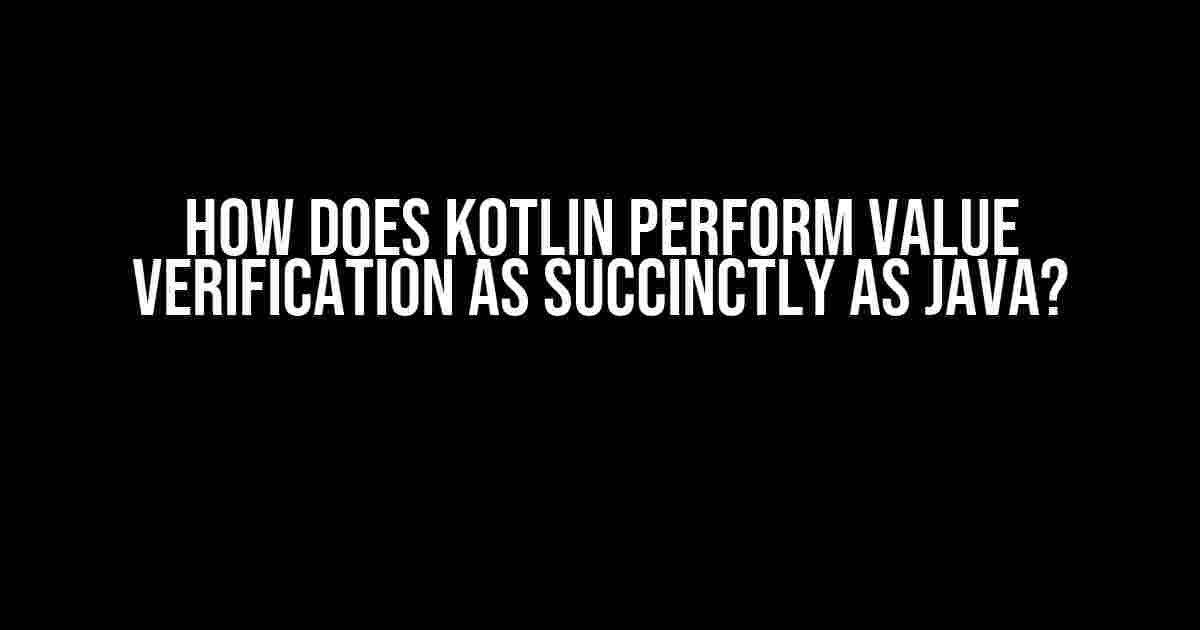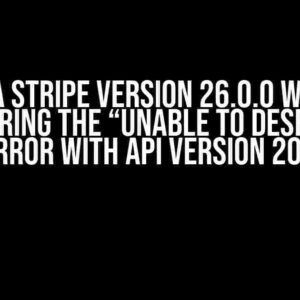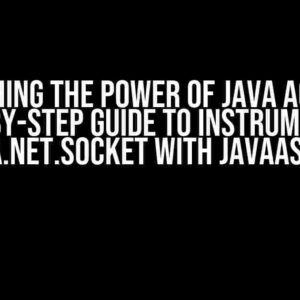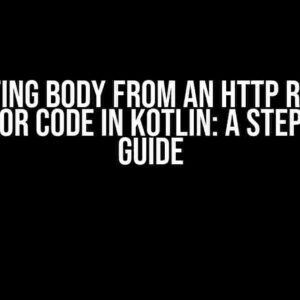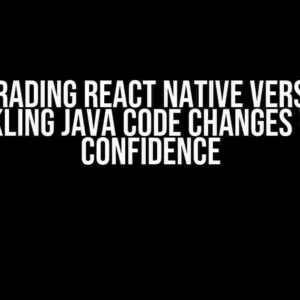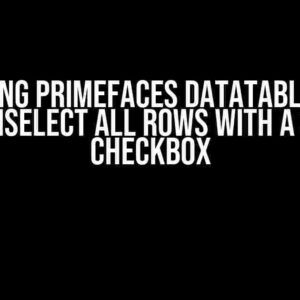Kotlin, the modern programming language, has been gaining popularity among developers due to its concise and safe coding features. One of the key aspects that sets Kotlin apart from Java is its ability to perform value verification with ease and simplicity. In this article, we’ll delve into the world of Kotlin and explore how it achieves value verification as succinctly as Java.
What is Value Verification?
Before we dive into the world of Kotlin, let’s first understand what value verification is. Value verification is the process of checking if a value falls within a certain range or meets specific conditions. This is an essential step in ensuring the correctness and reliability of your code. In Java, value verification is often performed using lengthy if-else statements or complex logical operations. However, Kotlin provides a more concise and expressive way to achieve value verification, making it a preferred choice among developers.
Kotlin’s Approach to Value Verification
Kotlin’s approach to value verification is centered around the concept of “null safety” and “smart casting”. Null safety ensures that your code is safe from null pointer exceptions by automatically checking for null values. Smart casting, on the other hand, allows you to perform type-safe casts without the need for explicit type checking.
null Safety in Kotlin
In Kotlin, you can use the `?` operator to denote a nullable type. For example:
var name: String? = "John"
This code declares a variable `name` of type `String?`, which means it can hold a null value. When you try to access the value of `name`, Kotlin will automatically check if it’s null before allowing the access.
Smart Casting in Kotlin
Kotlin’s smart casting feature allows you to perform type-safe casts without the need for explicit type checking. For example:
if (name !is String) {
println("Name is not a string")
} else {
println("Name is $name")
}
In this code, the `is` operator checks if the value of `name` is a `String`. If it’s not, the code inside the `if` block is executed. If it is, the code inside the `else` block is executed.
How Kotlin Performs Value Verification
Now that we’ve covered the basics of null safety and smart casting, let’s see how Kotlin performs value verification.
Range Checks
In Kotlin, you can perform range checks using the `in` operator. For example:
val age = 25
if (age in 18..65) {
println("Age is within the valid range")
} else {
println("Age is outside the valid range")
}
This code checks if the value of `age` falls within the range of 18 to 65.
Pattern Matching
Kotlin’s pattern matching feature allows you to perform complex value verification in a concise and expressive way. For example:
when (age) {
in 18..65 -> println("Age is within the valid range")
!in 18..65 -> println("Age is outside the valid range")
else -> println("Invalid age range")
}
This code uses pattern matching to check the value of `age` and perform different actions based on the result.
Data Classes
Data classes in Kotlin provide a simple way to perform value verification on objects. For example:
data class Person(val name: String, val age: Int)
val person = Person("John", 25)
if (person.age in 18..65) {
println("Age is within the valid range")
} else {
println("Age is outside the valid range")
}
This code defines a data class `Person` with properties `name` and `age`. It then creates an instance of `Person` and performs a range check on the `age` property.
Comparison with Java
Now that we’ve seen how Kotlin performs value verification, let’s compare it with Java.
Range Checks in Java
In Java, range checks are often performed using if-else statements. For example:
int age = 25;
if (age >= 18 && age <= 65) {
System.out.println("Age is within the valid range");
} else {
System.out.println("Age is outside the valid range");
}
This code performs a range check on the `age` variable using if-else statements.
Pattern Matching in Java
Java doesn't have built-in pattern matching, but you can use switch statements to achieve similar results. For example:
int age = 25;
switch (age) {
case 18:
case 19:
case 20:
// ...
case 65:
System.out.println("Age is within the valid range");
break;
default:
System.out.println("Age is outside the valid range");
}
This code uses a switch statement to perform a range check on the `age` variable.
Conclusion
In conclusion, Kotlin's approach to value verification is centered around null safety and smart casting. Kotlin's concise syntax and expressive features make it easier to perform value verification compared to Java. With features like range checks, pattern matching, and data classes, Kotlin provides a more robust and reliable way to ensure the correctness of your code.
| Feature | Kotlin | Java |
|---|---|---|
| Null Safety | Yes | No |
| Smart Casting | Yes | No |
| Range Checks | Yes | Yes |
| Pattern Matching | Yes | No |
| Data Classes | Yes | No |
This table summarizes the key differences between Kotlin and Java when it comes to value verification. Kotlin's concise syntax and expressive features make it a preferred choice among developers for performing value verification.
Best Practices for Value Verification in Kotlin
Here are some best practices to keep in mind when performing value verification in Kotlin:
- Use null safety features to prevent null pointer exceptions.
- Use smart casting to simplify type-safe casts.
- Use range checks to verify values within a specific range.
- Use pattern matching to perform complex value verification.
- Use data classes to simplify value verification on objects.
By following these best practices, you can ensure that your Kotlin code is robust, reliable, and easy to maintain.
Conclusion
In conclusion, Kotlin's approach to value verification is a game-changer in the world of programming. With its concise syntax and expressive features, Kotlin provides a more robust and reliable way to ensure the correctness of your code. By following the best practices outlined in this article, you can take your Kotlin coding skills to the next level and create more efficient and effective code.
Here are the 5 Questions and Answers about "How does Kotlin perform value verification as succinctly as Java":
Frequently Asked Question
Kotlin, the modern programming language, has gained popularity for its concise syntax and efficient coding practices. One of the interesting aspects of Kotlin is its ability to perform value verification as succinctly as Java. Let's dive deeper and explore how Kotlin achieves this feat!
Q1: How does Kotlin handle null safety?
Kotlin introduces the concept of nullable and non-nullable types, allowing developers to specify whether a variable can hold a null value or not. This feature helps prevent null pointer exceptions and ensures safer coding practices.
Q2: What is the role of smart casts in Kotlin?
Smart casts in Kotlin enable the compiler to track the state of a variable and automatically cast it to the correct type, eliminating the need for explicit casting. This feature reduces boilerplate code and makes value verification more concise.
Q3: How does Kotlin's Elvis operator simplify value verification?
The Elvis operator (`?:`) in Kotlin provides a concise way to handle null values by allowing developers to specify a default value to return if the original value is null. This feature makes value verification more expressive and reduces code verbosity.
Q4: Can Kotlin's extension functions contribute to value verification?
Yes, Kotlin's extension functions can be used to add custom validation logic to existing types, enabling more thorough value verification. This feature allows developers to write more expressive and reusable code.
Q5: How does Kotlin's type-safe builders enhance value verification?
Kotlin's type-safe builders provide a way to create hierarchical objects in a safe and concise manner. By using type-safe builders, developers can ensure that the constructed objects adhere to the expected structure, reducing errors and enhancing value verification.

